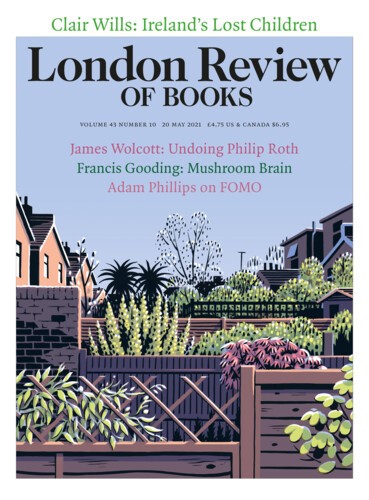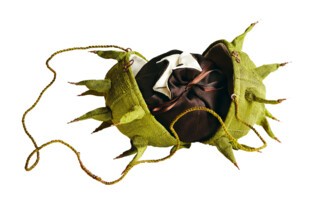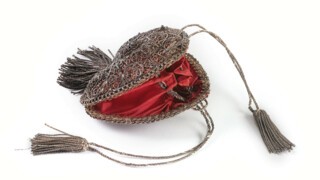The best ever riff on bags was written by Lucy Ellmann in her novel Doctors and Nurses (2006). In swirling prose she attacks – as if just knocking it out – the essential points about these essential accessories. The quick character guide they offer: ‘Tiny shiny hand-held PODS for flighty ice maidens; galumphing CARPET-BAGS for the jilted and jaded’. The utter absorption they can demand: ‘Nobody has HOBBIES anymore, but handbags were Jen’s hobby.’ Underlying it all, of course – her main THING – are the sexual revelations: ‘Men have their phallic ties, women their labial handbags.’ Meanwhile in the brochure – it hardly tries to be a catalogue – that accompanies the V&A’s Bags: Inside Out (reopening 17 May), bags get a desiccated write-up: a feeble foreword by Tristram Hunt, woolly captions, bland generalisations, brand worship. This doesn’t begin to do justice to the sometimes barmy bravura of what is on show.
The curator, Lucia Savi, has brought together items so varied in appearance and function, so 17th and so 21st century, so cosmopolitan and so country, so Myanmar and so Anya Hindmarch, so differently Turkish inflected – an 18th-century goat leather portfolio from Istanbul and a woollen suitcase from Tracey Emin – that ‘bags’ begins to look less like a category than an all-encompassing, constantly changing force. After seeing this show, it would be impossible to say that bags are not your bag. The items on display include a sturdy container for a Second World War gas mask; a delicate 2019 bucket woven from bamboo, silk and leather; a Versace pouch punctured with safety pins; and – hello, Lucy Ellmann – a tasselled 18th-century falconry bag whose inside pockets are embroidered with a woman in a scarlet slit of a skirt, a man with boots and a big horn, and a dead animal. Here is 17th-century filigree from Germany – silver wires twisted into the shape of a heart – and 20th-century jangle from Paris, supplied by Paco Rabanne’s chainmail belt bag.
‘Inside out’ it is not. No unexpected overarching bag narrative is unfolded, no secret history revealed. The layout is sober. A light open area is given over to design and manufacture, displaying stock books, opened like memorial volumes, with copperplate writing and compact pen sketches. Tools for working on leather are lined up as if for an operation. Their names – stitching horse, hand skiver, half-moon knife, strop – supply the most lively vocabulary in the exhibition. The bags themselves are laid out staidly: brilliant individuals captured behind glass, like rows of shrunken heads.
Supreme among the creations of the last century is the sleek, black ‘Normandie’ clutch, opulently framed in a crimson box. Created to celebrate the maiden voyage of the ocean liner Normandie in 1935, and presented as a gift to first-class passengers, it mirrors the sloping wedge of the ship, with a tiny metal anchor looped on the side and on top three gleaming clasps in the shape of funnels. The wit of the translation is made gloriously apparent by a photograph of the ship, with lights streaming from its portholes into the water.
Women are used to thinking that they dress up in order to become someone else, but a bag is the only accessory that itself regularly comes on as something else. A 17th-century ‘sweet purse’, made of silk and metal and intended to be filled with dried flowers or herbs, is shaped like a jumping frog. Foliage and fruit (the exhibition is sponsored by Mulberry) have always dangled from women’s arms. One might have expected a cluster of pineapple reticules from the pineapple-worshipping era. Emily Jo Gibbs’s green spiked ball of a design is more adventurous. Modelled on a horse chestnut, it opens to show a conker purse tethered to the inside, a delicate knobkerrie. The cosh echo is resounding for anyone who has swung a shoulder bag at a wanker. I’m thinking unmetaphorically of the chap who, working away at himself one night in Lamb’s Conduit Street, managed to dodge being biffed by my bag.
Weapons and refuges. Or, like Winnie’s bag in Happy Days, proof of a regulated existence; a vivid alternative to being buried up to your neck in daily life. Some bags provide 3D evidence of routines that are on the point of looking arcane. Vivien Leigh’s attaché case (it is sometimes worth stretching the idea of what counts as a bag) is a portable office: scarlet, of course, with scalloped divisions for paper and stamps, and three matching address books for Paris, London and New York. An opera bag made in Paris in 1910 provides an ivory-tinted souvenir of sumptuous evenings. Sixteen centimetres when closed, it opens to reveal, like a doll’s house, boxy compartments for opera glasses, a collapsible fan and a powder puff, a purse for change and a pocket for a notebook and pencil.
These arrangements don’t require explanation, and they don’t get it at the V&A, which doesn’t offer much in the way of documentation. Still, a rare photograph of a bag on the go shows how completely it can focus a look. Jane Fonda, snapped while shooting La Curée in 1965, has the chain strap of a quilted Chanel bag looped over her arm. No downward dangle here: it swings at an angle, echoing the jaunty tilt of her on-the-knee coat and high heels. Everything light and spry. Everything unencumbered. Because, efficient as that squashy oblong appears in isolation, a heap of portable items has to be left outside it. Fonda has documents in her hand, a newspaper tucked under her arm; behind her is a porter, another kind of (man)bag, with serious luggage. I would like to have seen Hilde Wagner-Ascher’s cotton and metal envelope-style bag, designed nearly a hundred years ago for the Wiener Werkstätte, doing its job in sympathetic surroundings. The canny geometry of its all-over design – seamless loops and stripes of fawn and beige and brown – would be no less marvellous if seen as one example of a shared project, a wrapping together of arts and crafts, architecture and soft fabric.
Brand is treated as vision here. It would be absurd to exclude Marc Jacobs’s Speedy Handbag (2006), lugged in gold and silver by Paris Hilton and Kim Kardashian. But it would have been humane to take some scissors to the vapidities that surge through the ‘Status and Identity’ section: cognoscenti/revenue/celebrity endorsement/exclusive award ceremony/aspiration. Two years ago, the Monnaie de Paris went to the unworldly other extreme with its exquisite show L’Art du porte-monnaie. Captions were crisp; the practical, meticulous catalogue included a useful purse lexicon and an image of a fine 1877 advertisement for a Parisian clasp-maker. Here was a perfect meeting of precision and performance. Scenographers helped to stage the exhibition, and based their design on late 19th-century shop windows as well as on cabinets of curiosities. The purses shone like tropical fish in low-lit tanks. Floppy pouches and rigid coffers, made of mussel shells, tin, mother of pearl, sculpted ivory, porcelain, painted wood; shaped like a hand or a pair of bellows; one clasp decorated with a model train, another with a golden odalisque; a leather piece containing a compartment for tools to trim and shape a moustache. Low ceilings; no clatter; an air of rapt theatricality. As if all this precious stuff had nothing to do with money.
Both these shows have their glories. Both leave room for more – more artefacts, more commentary. The routine use of female clothing as a jeer (‘big girl’s blouse’ is, yes prime minister, more explicitly gender-specific than ‘stuffed shirt’) reaches its peak/nadir when it comes to bags. What is the male equivalent to ‘old bag’? One of the most elegant and potentially noisy objects at the V&A is a 19th-century cut-steel (‘probably England’) chatelaine, from which are suspended thirteen items – including scissors, thimble, notebook, purse and magnifying glass. How often is the name of a man’s job given to a portable accessory? The pouch containing darning wool and needles with which British soldiers were equipped in World War Two was called a housewife. Any socially inquisitive exhibition would also have to pay some attention to the queen and her apparently loyal attachment to her handbag. She isn’t short of places in which to conceal a hankie or a panic button, so why does she carry her bag around her home ? Is it, rather sympathetically, for comfort? A bag on the end of a handle is like a silent hound on a leash.
The V&A bags are almost all shown closed; when opened, they are empty. No solitary paracetamol or leaky biro. The private lives of bags deserve another show. It would be enormous and it would be sensational. You don’t often get to peer into someone else’s bag. I still remember the admiration with which, looking into a fellow student’s shoulder bag many years ago, I saw her diary, make-up bag and comb stacked upright as if in a filing cabinet – and recognised the mind that had scythed through essays. The quickest way to signal middle-aged female distress on stage is to show a woman rummaging frantically in a bag. Irritating though this is, there is some truth in it. Losing something in your bag is peculiarly designed to make your brain feel as if it is melting, the fabric equivalent of a computer collapse.
Women have bags because they no longer have pockets: the unreasonableness of this was first made evident to me when I read Gwen Raverat’s Period Piece. What was once inside is now out – which is part of Lucy Ellmann’s point. Her interest is continuous with that of Samuel Richardson, another innovative novelist, who, living in the Pocket Era, created in one of his heroines a delicious paradox. Pamela tucks her secret correspondence into pockets hung beneath her skirts. The woman dedicated to keeping her purity intact has to keep groping her private parts to get at her life. Even the vocabulary of bags is slippery, as the writer James Fox found when, dining next to a radio show hostess, he looked at the small purse she had perched on the table and startled her by praising her ‘nice little snatch’. Clutch, clutch is the word. ‘I sometimes think you expect too much of a bag,’ my mother observed when I was a teenager. Surely that isn’t possible?
Send Letters To:
The Editor
London Review of Books,
28 Little Russell Street
London, WC1A 2HN
letters@lrb.co.uk
Please include name, address, and a telephone number.



